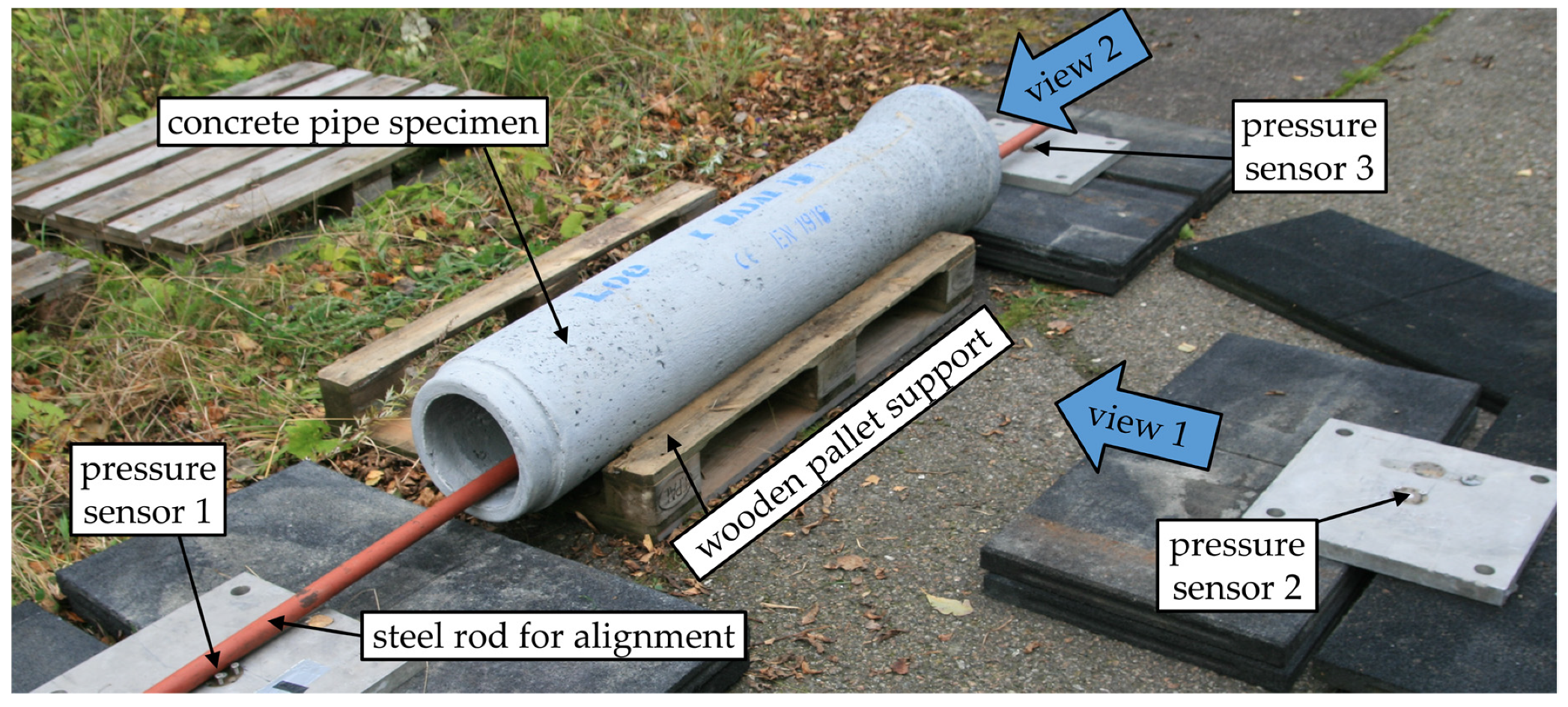Blast Loading of Concrete Pipes Using C-4 Charges †
Abstract
:1. Introduction
2. Concrete Pipes
3. Blast Load Testing
3.1. Test Setup
3.2. Experimental Results
4. Numerical Simulations
4.1. Numerical Setup
4.2. Simulation Results
5. Concluding Remarks
Author Contributions
Acknowledgments
Conflicts of Interest
References
- Norwegian Public Roads Administration, the E39 Coastal Highway Route. Available online: http://www.vegvesen.no/Vegprosjekter/FerjefriE39/English (accessed on 16 April 2018).
- Eidem, M.; Minoretti, A.; Sekse, J.H. Proposal for a submerged floating tube bridge as part of the Bømlafjord crossing. In Proceedings of the 19th Congress of the International Association for Bridge and Structural Engineering (IABSE), Stockholm, Sweden, 21–23 September 2016; p. Stock-0470-2016-R1. [Google Scholar]
- Remseth, S.; Leira, B.J.; Okstad, K.M.; Mathisen, K.M.; Haukås, T. Dynamic response and fluid/structure interaction of submerged floating tunnels. Comput. Struct. 1999, 72, 659–685. [Google Scholar] [CrossRef]
- Xiang, Y.; Yang, Y. Spatial dynamic response of submerged floating tunnels under impact load. Mar. Struct. 2017, 53, 20–31. [Google Scholar] [CrossRef]
- Peroni, M.; Solomos, G.; Caverzan, A.; Larcher, M.; Valsamos, G. Assessment of dynamic mechanical behaviour of reinforced concrete beams using a blast simulator. EPJ Web Conf. 2015, 94. [Google Scholar] [CrossRef]
- Kristoffersen, M.; Pettersen, J.E.; Aune, V.; Børvik, T. Experimental and numerical studies on the structural response of normal strength concrete slabs subjected to blast loading. Eng. Struct. 2018, in press. [Google Scholar] [CrossRef]
- Oña, M.; Morales-Alonso, G.; Gálvez, F.; Sánchez-Gálvez, V.; Cendón, D. Analysis of concrete targets with different kinds of reinforcements subjected to blast loading. EPJ Spec. Top. 2016, 225, 265–282. [Google Scholar] [CrossRef]
- SIMULIA. ABAQUS 6.14 Online Documentation; Dassault Systèmes: Vélizy-Villacoublay, France, 2014. [Google Scholar]
- Kingery, C.N.; Bulmash, G. Technical Report ARBRL-TR-02555: Airblast Parmeters from TNT Spherical Air Burst and Hemispherical Surface Burst; Aberdeen Proving Ground, Maryland; Defense Technical Information Center: Alexandria, VA, USA, 1984. [Google Scholar]
- Conrath, E.J.; Krauthammer, T.; Marchand, K.A.; Mlakar, P.F. Structural Design for Physical Security, 2nd ed.; American Society of Civil Engineers: Reston, VA, USA, 1999; pp. 2–7 and 2–8. [Google Scholar]
- Lubliner, J.; Oliver, J.; Oller, S.; Oñate, E. A plastic-damage model for concrete. Int. J. Solids Struct. 1989, 25, 299–326. [Google Scholar] [CrossRef]
- Lee, J.; Fenves, G.L. Plastic-damage model for cyclic loading of concrete. J. Eng. Mech. 1998, 124, 892–900. [Google Scholar] [CrossRef]
- Kristoffersen, M.; Minoretti, A.; Børvik, T. Submerged floating tunnels subjected to internal blast loading. In Proceedings of the 7th Transport Research Arena (TRA), Vienna, Austria, 16–19 April 2018; p. 11360. [Google Scholar]





| Pipe ID | Charge Position | R [mm] | W [g] | Z [m∙kg1/3] | P1 [bar] | P2 [bar] | P3 [bar] | Comment |
|---|---|---|---|---|---|---|---|---|
| III | (i) | 100 | 10.0 | 0.464 | 1.68 | 0.21 | 2.22 | Intact |
| IV | (i) | 100 | 12.5 | 0.431 | 2.13 | 0.24 | 2.64 | Surface cracks |
| VI | (i) | 100 | 13.5 | 0.420 | 2.10 | 0.17 | 2.69 | Large pcs. |
| VIII | (ii) | 0 | 5.0 | - | 1.19 | 0.16 | 1.44 | Scabbing, spalling |
| XV | (ii) | 0 | 6.0 | - | 1.23 | 0.28 | 1.49 | Broke in two, spall |
| IX | (ii) | 0 | 7.5 | - | 1.31 | 0.28 | 1.71 | Large pieces, spall |
| VII | (ii) | 0 | 10.0 | - | 1.39 | 0.18 | 2.02 | More, smaller pcs. |
| XI | (iii) | 0 | 10.0 | - | 0.35 | 0.45 | 0.33 | Crater in and out |
| XVI | (iii) | 0 | 12.5 | - | 0.47 | 1.14 | 0.89 | Small hole |
| XII | (iii) | 0 | 15.0 | - | 0.28 | 0.81 | 0.57 | A bit bigger hole |
Publisher’s Note: MDPI stays neutral with regard to jurisdictional claims in published maps and institutional affiliations. |
© 2018 by the authors. Licensee MDPI, Basel, Switzerland. This article is an open access article distributed under the terms and conditions of the Creative Commons Attribution (CC BY) license (https://creativecommons.org/licenses/by/4.0/).
Share and Cite
Kristoffersen, M.; Hauge, K.O.; Børvik, T. Blast Loading of Concrete Pipes Using C-4 Charges. Proceedings 2018, 2, 428. https://doi.org/10.3390/ICEM18-05292
Kristoffersen M, Hauge KO, Børvik T. Blast Loading of Concrete Pipes Using C-4 Charges. Proceedings. 2018; 2(8):428. https://doi.org/10.3390/ICEM18-05292
Chicago/Turabian StyleKristoffersen, Martin, Knut Ove Hauge, and Tore Børvik. 2018. "Blast Loading of Concrete Pipes Using C-4 Charges" Proceedings 2, no. 8: 428. https://doi.org/10.3390/ICEM18-05292





